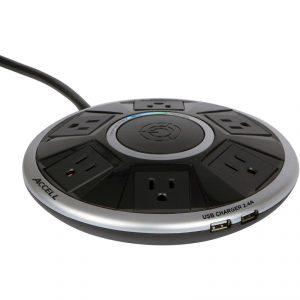You’ve already got a laundry list of necessary and/or helpful accessories that you pull out of storage and ship to your meetings and events. Here are some more smart tools for onsite productivity that you may have overlooked or not previously considered. Better yet, the functionality of these items are useful beyond onsite event management, they can all be incorporated into your daily job to enhance productivity and/or just make life easier.
Smart Power Strips for Events or Mobile Offices
Setting up your base or office onsite comes with a variety of simple tech challenges that vary from venue to venue—connecting to the net, printers and securing enough power plugs for all of your essential devices. Power strip surge protectors have eked into our daily lives over the years, yet, too often, are left out of the onsite travel kit.
If you do bring a surge protector along to your event, chances are it’s old (maybe the indicator light blinks incessantly, not a characteristic that inspires confidence), or ugly (its once-clean off-white color deteriorated into a sickly yellowed plastic that looks like a 1990s tower PC from the room of a chain smoker?). If that sounds familiar, then it certainly doesn’t have the now-necessary USB charging plugs required to power the myriad of portable devices found onsite. My power strips fit the above bill, so I was excited to try Accell’s Powramid Air ($35.99), when they offered a trial.

Not only does it look awesome—like a sleek UFO, with a softly glowing center—but the six outlets are perfectly spaced to accommodate large plugs (you know, the kind that would typically overlap other ports, limiting the number of devices you can connect or requiring you to shuffle plugs around like a puzzle trying to find the positioning that allows the most plugs to fit). And there are two USB ports!
The Powramid Air is lightweight, yet solid and simply works. The price is slightly more than your standard power strip, but due to the design, you can actually utilize every port. The next step will be an equally attractive device with more USB ports and a built-in wireless charging component.
Smart Watches to Keep you Connected
As we’re increasingly connected to everything and on the receiving end of constant auditory signals screaming, “Look at me—you’ve got an important message!” I’ve managed to find some semblance of peace for more than three years thanks to the Moto
360 smart watch. How so?

When smart phones first came out, like most people, I was quick to apply custom ringtones and notifications—the sounds were fun for about a week, then I’d change them repeatedly, bored or annoyed quickly. Over time, I grew to despise the demanding sounds and increasingly kept my phone on silent-vibrate—unless urgent messages were expected. Like many users, I even began feeling phantom vibrations—there was no call or notification, but my expectant senses told me the device was buzzing.
That was all resolved after I began using a first-generation Moto 360 Android smart watch in 2015. I’ve always loved watches, but the miniature hockey puck-looking thing now on my wrist acts as my lifeline to the connected world while freeing me from the beeps and rings. You see, my phone is now on “silent-vibrate only” 24 hours a day, but I don’t have to keep it on my person because my Moto 360, connected via Bluetooth, gives a little vibration on my wrist when my attention is being summoned. From that point, I just quickly glance at the watch for calendar reminders, to read and respond to text messages and to answer (or decline) calls.
All the while, the phone—taunting my attention with promises of breaking news, Words with Friends opportunities, Twitter mentions, etc.—remains untouched somewhere in my general vicinity. When working conferences and in my daily life, the effect is one of less distraction and greater focus on what’s important—if I’m not looking at my phone’s screen, I’m not being pulled into unnecessary tasks.
Since the introduction of smart watches a few years ago, prices have plummeted. Worried about the lasting functionality of such a device? Don’t be—my Moto 360 is the oldest model Android smart watch, yet it still does everything promised when it debuted in 2015. Even the battery and wireless charging base continue to function perfectly. After about a year, I did replace the leather band with a silicon version, for both comfort and appearance, but that was merely a $10 enhancement via Amazon that took about 60 seconds to change out.
First-generation Moto 360 smart watches are now available for $40 or less, refurbished. The slightly thinner newer generations sell for as little as $200 new ($70 used). Of course, there are a bevy of other Android smart watches, many virtually identical to the Moto 360, save for cosmetic differences, from manufacturers such as LG, Huawei, Fossil, Samsung, etc. The Apple Watch offers the same benefits to the end user—potentially more benefits if you’re dedicated to that operating system landscape—starting at around $150 for Series 1. Regardless of the brand, just remember, these wearables can’t do everything you’d ideally like (not yet, at least); they are, first and foremost, watches.
Smart Locks to Secure Event or Office Items
I’ve not yet tested such devices, but I can envision the usefulness especially onsite during a meeting or event. You need to secure items (think of materials left overnight at exhibition booths or even in rooms), usually you just have to trust onsite security or remember to swap keys between whoever is closing a room at night with whoever is opening the room in the morning.

Enter the Tapplock one, a super-versatile smart padlock that can be accessed by numerous routes. Tapplock one can store the fingerprints of up to 500 individuals, or you can use the smart phone app to remotely unlock (and even view access history!).
The world of smart locks is one I hope to explore the next time I’ve got the need.
What smart tools do you use and recommend?
What devices do you find enhance your onsite productivity that you think peers have overlooked? Let us know in the comments below!







